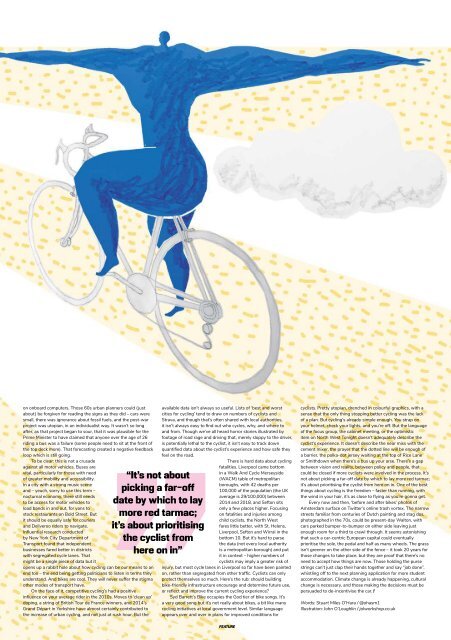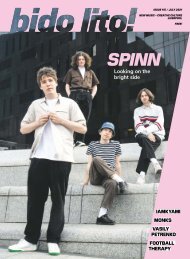Issue 109 / September 2020
September 2020 issue of Bido Lito! magazine. Featuring: TEE, JAMIE WEBSTER, ALL WE ARE, DECAY, MOLLY GREEN, FRAN DISLEY, FUTURE YARD, WHERE ARE THE GIRL BANDS and much more.
September 2020 issue of Bido Lito! magazine. Featuring: TEE, JAMIE WEBSTER, ALL WE ARE, DECAY, MOLLY GREEN, FRAN DISLEY, FUTURE YARD, WHERE ARE THE GIRL BANDS and much more.
Create successful ePaper yourself
Turn your PDF publications into a flip-book with our unique Google optimized e-Paper software.
on onboard computers. Those 60s urban planners could (just<br />
about) be forgiven for reading the signs as they did – cars were<br />
small, there was ignorance about fossil fuels, and the post-war<br />
project was utopian, in an individualist way. It wasn’t so long<br />
after, as that project began to sour, that it was plausible for the<br />
Prime Minister to have claimed that anyone over the age of 26<br />
riding a bus was a failure (some people need to sit at the front of<br />
the top deck more). That forecasting created a negative feedback<br />
loop which is still going.<br />
To be clear: this is not a crusade<br />
against all motor vehicles. Buses are<br />
vital, particularly for those with need<br />
of greater mobility and accessibility.<br />
In a city with a strong music scene<br />
and – yeuch, sorry to use this term –<br />
nocturnal economy, there still needs<br />
to be access for motor vehicles to<br />
load bands in and out, for vans to<br />
stock restaurants on Bold Street. But<br />
it should be equally safe for couriers<br />
and Deliveroo riders to navigate.<br />
Influential research conducted<br />
by New York City Department of<br />
Transport found that independent<br />
businesses fared better in districts<br />
with segregated cycle lanes. That<br />
might be a single piece of data but it<br />
opens up a rabbit hole about how cycling can be our means to an<br />
end too – the end being getting politicians to listen in terms they<br />
understand. And bikes are cool. They will never suffer the stigma<br />
other modes of transport have.<br />
On the face of it, competitive cycling’s had a positive<br />
influence on your average rider in the 2010s. Moves to ‘clean up’<br />
doping, a string of British Tour de France winners, and 2014’s<br />
Grand Départ in Yorkshire have almost certainly contributed to<br />
the increase of urban cycling, and not just at rush hour. But the<br />
“It’s not about<br />
picking a far-off<br />
date by which to lay<br />
more red tarmac;<br />
it’s about prioritising<br />
the cyclist from<br />
here on in”<br />
available data isn’t always so useful. Lists of ‘best and worst<br />
cities for cycling’ tend to draw on numbers of cyclists and<br />
Strava, and though that’s often shared with local authorities,<br />
it isn’t always easy to find out who cycles, why, and where to<br />
and from. Though we’ve all heard horror stories illustrated by<br />
footage of road rage and driving that, merely sloppy to the driver,<br />
is potentially lethal to the cyclist, it isn’t easy to track down<br />
quantified data about the cyclist’s experience and how safe they<br />
feel on the road.<br />
There is hard data about cycling<br />
fatalities. Liverpool came bottom<br />
in a Walk And Cycle Merseyside<br />
(WACM) table of metropolitan<br />
boroughs, with 42 deaths per<br />
100,000 of the population (the UK<br />
average is 29/100,000) between<br />
2014 and 2018, and Sefton sits<br />
only a few places higher. Focusing<br />
on fatalities and injuries among<br />
child cyclists, the North West<br />
fares little better, with St. Helens,<br />
Liverpool, Sefton and Wirral in the<br />
bottom 10. But it’s hard to parse<br />
the data (not every local authority<br />
is a metropolitan borough) and put<br />
it in context – higher numbers of<br />
cyclists may imply a greater risk of<br />
injury, but most cycle lanes in Liverpool so far have been painted<br />
on, rather than segregated from other traffic. Cyclists can only<br />
protect themselves so much. Here’s the rub: should building<br />
bike-friendly infrastructure encourage and determine future use,<br />
or reflect and improve the current cycling experience?<br />
Syd Barrett’s Bike occupies the God tier of bike songs. It’s<br />
a very good song but it’s not really about bikes, a bit like many<br />
cycling initiatives at local government level. Similar language<br />
appears over and over in plans for improved conditions for<br />
cyclists. Pretty utopian, drenched in colourful graphics, with a<br />
sense that the only thing stopping better cycling was the lack<br />
of a plan. But cycling’s already simple enough. You strap on<br />
your helmet, check your lights, and you’re off. But the language<br />
of the focus group, the cabinet meeting, or the optimistic<br />
item on North West Tonight doesn’t adequately describe the<br />
cyclist’s experience. It doesn’t describe the near miss with the<br />
cement mixer, the prayer that the dotted line will be enough of<br />
a barrier, the polka-dot jersey waiting at the top of Rice Lane<br />
or Smithdown when there’s a bus up your arse. There’s a gap<br />
between vision and reality, between policy and people, that<br />
could be closed if more cyclists were involved in the process. It’s<br />
not about picking a far-off date by which to lay more red tarmac;<br />
it’s about prioritising the cyclist from here on in. One of the best<br />
things about cycling is the freedom – faster than running, with<br />
the wind in your hair, it’s as close to flying as you’re gonna get.<br />
Every now and then, ‘before and after bikes’ photos of<br />
Amsterdam surface on Twitter’s online trash vortex. The narrow<br />
streets familiar from centuries of Dutch painting and stag dos,<br />
photographed in the 70s, could be present-day Walton, with<br />
cars parked bumper-to-bumper on either side leaving just<br />
enough room for a third to crawl through. It seems astonishing<br />
that such a car-centric European capital could eventually<br />
prioritise the sole, the pedal and half as many wheels. The grass<br />
isn’t greener on the other side of the fence – it took 20 years for<br />
those changes to take place, but they are proof that there’s no<br />
need to accept how things are now. Those holding the purse<br />
strings can’t just clap their hands together and say “job done”,<br />
whistling off to the next planning application for more student<br />
accommodation. Climate change is already happening, cultural<br />
change is necessary, and those making the decisions must be<br />
persuaded to de-incentivise the car. !<br />
Words: Stuart Miles O’Hara / @ohasm1<br />
Illustration: John O’Loughlin / jolworkshop.co.uk<br />
FEATURE<br />
33

















